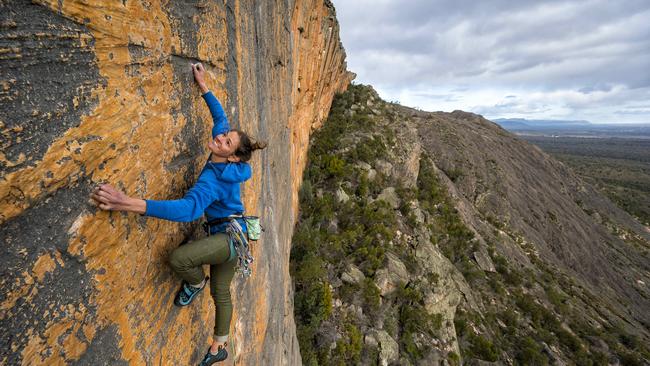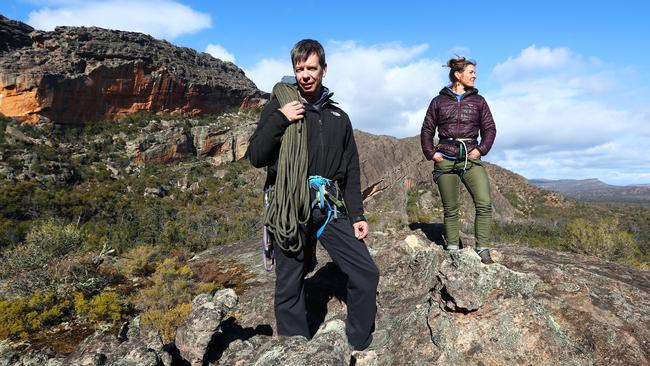Climbers clinging on after being told to sling their hooks
Deep in the bush, one stroke of a bureaucrat’s pen has imperilled a multi-million dollar industry.

The secret to finding peace and adrenaline in equal measure in Victoria’s Grampians National Park is going deep and high.
Deep into the bush, far from the mainstream tourist trail in and around Halls Gap, and high on the rocks, where few tread.
For Australia’s climbing industry, that pursuit of tranquillity at the southern tip of the Great Dividing Range has ended in deep disappointment and potential court action after the state government banished the sport from large parts of one of the world’s great climbing theatres.
Simon Carter, a Blue Mountains-based climbing photographer with a global reputation, published a book on the routes in the Grampians and is one of many of the industry’s stunned leaders trying to carve a path forward.
In one stroke of the bureaucratic pen, Parks Victoria has closed more than 500sq km to climbing and is threatening to hand out $1611 fines, imperilling the sport and casting a shadow over a multi-million-dollar adventure tourism attraction.

At the heart of the bans are claims of mistreatment of Aboriginal rock art and environmental damage, sparking a ferocious battle with a sport that carved its reputation on its green credentials. It may well end in court as climbing activists raise cash for a so-called “access fund’’ and the government ploughs ahead with a new management plan being worked on by Parks Victoria.
Few things come closer to environmental activism than a collective of climbers, a community that traditionally shuns the madding crowd.
“If you are going to ban climbing you might as well ban bushwalking,’’ Carter said yesterday at the northern tip of the ranges.
“Just look around at some of the popular (walking) tracks, all the litter, graffiti, faeces, vegetation and infrastructure. Basically, we have been the subject of a disgusting and shocking smear campaign from Parks Victoria.’’
Considered in the top group of climbing destinations in the world because of its variety and vast number of routes, the Grampians is a prime site for overseas visitors.
Standing near the Taipan Wall yesterday, British climber Alistair Kennedy said he and his partner had travelled from Bristol to climb in the area and he was surprised by the push. “It’s unique, we’ve come from the other side of the world just to climb here,’’ he said.
Parks Victoria chief operating officer Simon Talbot is not backing away from his criticism of sections of the sport, which he has accused of cultural vandalism, using bolts inappropriately and crashing through vegetation in pursuit of a vertical thrill.
“You can’t go to a national park and just cut a track in,’’ he said.
But the law-abiding majority are furious with the way climbers have been characterised during the debate, accusing the government of deliberate misinformation. Authorities were forced to retract a claim that climbers had driven a bolt through Aboriginal rock art. The bolt had been placed decades ago by parks officials.
Parks Victoria has started fining people for climbing in certain areas, pointing to a 2003 management plan that created eight protection areas where some sports could not be carried out.
But amid increased tourist activity and lobbying from local indigenous groups worried about damage to cultural sites, Parks Victoria has swooped on climbers, citing, among other things, the use of drills and chalk on rock faces, lighting fires outside of designated fireplaces and smashing vegetation while bouldering.
A prominent defender of the sport, Mike Tomkins, says the extreme examples of alleged vandalism are deliberate distortions of the truth, masking a wider agenda to shut down large parts of the park. “It’s scandalous,’’ he says. “It’s been hurtful and harmful. The bans are illegal.”
Locals are confused. Nationals state member for Lowan Emma Kealy says the parties want a resolution that respects and preserves cultural sites but allows meaningful access for climbers.
While much of the attention has focused on the impact on high-end sports climbing, the Grampians are considered its nursery, particularly Summer Day Valley in the north.
Daniel Pearl is a private operator who has taught thousands of children in the valley but has been told the area may have a limited lifespan for teaching. “Finding another site isn’t straightforward,’’ he said. “The way they have shut down vast areas has been really inappropriate.’’


To join the conversation, please log in. Don't have an account? Register
Join the conversation, you are commenting as Logout